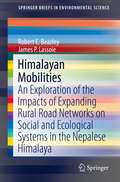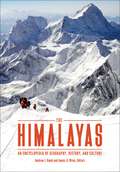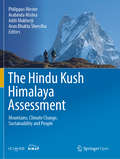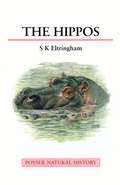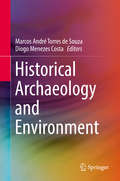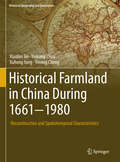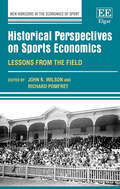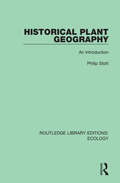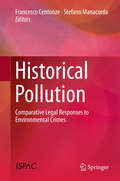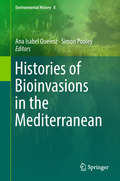- Table View
- List View
Himalayan Journals, Volume II: Scientific Travellers 1790-1877 Volume 2
by Joseph Dalton HookerThis is Volume II of the Himalayan Journals or the notes of a naturalist travelling in Bengal, The Sikkim and Nepal Himalayas, the Khasia Mountains.
Himalayan Mobilities: An Exploration of the Impact of Expanding Rural Road Networks on Social and Ecological Systems in the Nepalese Himalaya (SpringerBriefs in Environmental Science)
by Robert E. Beazley James P. LassoieThe goals of this book are to update information on the effects of rural road development, both in Nepal and globally, explain the environmental, socioeconomic, and sociocultural impacts of expanding rural road networks in the Nepalese Himalaya, and to promote further studies on rural road development throughout the world based on studies and investigations performed in Nepal. Readers will learn about the history of rural road development, as well as the challenges to effectively design and construct rural roads and how these obstacles may be overcome.Chapter one offers a global review of road development, and both the positive and negative impacts of rural road implementation. Chapter two defines mobilities within the context of coupled social and ecological systems, specifically in the Nepalese Himalaya. Chapters three through five detail the environmental, socioeconomic, and sociocultural impacts expanding rural road networks through several case studies. The concluding chapter summarizes the findings of the book, discussing the need for interdisciplinary cooperation and collaboration to avoid negative consequences. This book will be of interest to teachers, researchers, policy makers, and development organizations.
The Himalayan Soap Pod Tree (Gymnocladus assamicus): An Ecologically and Economically Important Tree on the Brink of Extinction
by Dr Baharul I Choudhury Professor Mohammed Latif KhanExtinction of species has alarmingly increased in recent decades due to anthropogenic activities, natural calamities and climate change. The life history, ecology and evolution of such species have often not been well studied. Gymnocladus assamicus is an archaic tree endemic to the Eastern Himalayan region of Northeast India. Locally known as 'Menangmanba-shi' by the Monpa tribe of Arunachal Pradesh (India), mature G. assamicus pods contain high saponin and are used traditionally for cleansing purposes and rituals. We rediscovered the species after more than 70 years from high altitude areas in the Himalayas through extensive field explorations and employing an ecological niche modeling approach. Our study revealed a very few actively reproducing mature G. assamicus trees surviving in unique microclimatic conditions. The species is classified as 'critically endangered' (IUCN red list). The book contains detailed information about G. assamicus and discusses its current distribution, population status, ethnobotanical uses and other ecological parameters. Major intrinsic and extrinsic factors that might be responsible for population decline are described. More importantly, we reported a very rare mating system known as 'androdioecy' in which male and hermaphrodite individuals co-exist in the natural population. Overall, the book highlights the story of a critically endangered tree species with a unique biological and socio-cultural importance and will serve as a case study and referencefor other similar species both locally and globally.
The Himalayas: An Encyclopedia of Geography, History, and Culture
by Andrew J. Hund and James A. WrenA thorough and detailed resource that describes the history, culture, and geography of the Himalayan region, providing an indispensable reference work to both general readers and seasoned scholars in the field.The Himalayas: An Encyclopedia of Geography, History, and Culture serves as a convenient and authoritative reference for anyone exploring the region and seeking to better understand the history, events, peoples, and geopolitical details of this unique area of the world. It explores the geography and details of the demographics, discusses relevant historical events, and addresses socioeconomic movements, political intrigues and controversies, and cultural details as to give an overarching impression of the region as a coherent and cohesive whole. Readers will come away with a vastly heightened understanding of the geographical region we recognize as the Himalayas, and grasp the issues of geography, history, and culture that are central to contemporary understandings of the human culture in the region.The alphabetically arranged and succinct entries provide easy access to detailed, authoritative information. Additionally, sidebars throughout the book relate compelling facts that point readers to new and interesting avenues of exploration. The volume also includes a chronological overview of the region, ten primary source documents, and a comprehensive bibliography of supporting works.
The Himalayas: An Encyclopedia of Geography, History, and Culture
by Andrew J. Hund James A. WrenA thorough and detailed resource that describes the history, culture, and geography of the Himalayan region, providing an indispensable reference work to both general readers and seasoned scholars in the field.The Himalayas: An Encyclopedia of Geography, History, and Culture serves as a convenient and authoritative reference for anyone exploring the region and seeking to better understand the history, events, peoples, and geopolitical details of this unique area of the world. It explores the geography and details of the demographics, discusses relevant historical events, and addresses socioeconomic movements, political intrigues and controversies, and cultural details as to give an overarching impression of the region as a coherent and cohesive whole. Readers will come away with a vastly heightened understanding of the geographical region we recognize as the Himalayas, and grasp the issues of geography, history, and culture that are central to contemporary understandings of the human culture in the region.The alphabetically arranged and succinct entries provide easy access to detailed, authoritative information. Additionally, sidebars throughout the book relate compelling facts that point readers to new and interesting avenues of exploration. The volume also includes a chronological overview of the region, ten primary source documents, and a comprehensive bibliography of supporting works.
Hindsight: In Search of Lost Wilderness
by Jenna Watt'Essential reading for lovers of the Great outdoors' – Roger Cox, Scotsman Magazine In 2019, Jenna Watt took part in the stalking of a hind on the vast Highland estate of Corrour: part of an immersive attempt to understand the ideas that lie behind ‘rewilding’, and what it means emotionally and physically to participate in Scotland’s deer cull. Piece by piece and chapter by chapter she unravels the story of that one day spent hunting the hind, interlaced with her discovery that her ancestors were deer stalkers, game keepers and ghillies on a Highland estate, who once took part in increasingly controversial land practices like muirburn and species persecution. This exploration leads her into the complex and often conflict-ridden world of the rewilding movement. She meets the ‘Wolf Man’ of the Highlands, who wants to introduce the first wild wolves back into Scotland for over 300 years; a mountain ecologist who ranges alone across the landscape to track the environmental impact of deer on Scotland’s upland ecosystem; landowners who are reintroducing species like beaver, ospreys and sea-eagles onto their estates; and a female deer stalker, who is trying to introduce more women into the male-dominated world of stalking and game-keeping. In the process, Jenna comes to better understand the meaning of ‘wildness’, the shifting baselines of ‘rewilding’, and, in a world beset by climate change and species extinction, how to cope, both as an individual and as a society, with the concept of ecological grief.
The Hindu Kush Himalaya Assessment: Mountains, Climate Change, Sustainability and People
by Philippus Wester Arabinda Mishra Aditi Mukherji Arun Bhakta ShresthaThis open access volume is the first comprehensive assessment of the Hindu Kush Himalaya (HKH) region. It comprises important scientific research on the social, economic, and environmental pillars of sustainable mountain development and will serve as a basis for evidence-based decision-making to safeguard the environment and advance people’s well-being. The compiled content is based on the collective knowledge of over 300 leading researchers, experts and policymakers, brought together by the Hindu Kush Himalayan Monitoring and Assessment Programme (HIMAP) under the coordination of the International Centre for Integrated Mountain Development (ICIMOD). This assessment was conducted between 2013 and 2017 as the first of a series of monitoring and assessment reports, under the guidance of the HIMAP Steering Committee: Eklabya Sharma (ICIMOD), Atiq Raman (Bangladesh), Yuba Raj Khatiwada (Nepal), Linxiu Zhang (China), Surendra Pratap Singh (India), Tandong Yao (China) and David Molden (ICIMOD and Chair of the HIMAP SC).This First HKH Assessment Report consists of 16 chapters, which comprehensively assess the current state of knowledge of the HKH region, increase the understanding of various drivers of change and their impacts, address critical data gaps and develop a set of evidence-based and actionable policy solutions and recommendations. These are linked to nine mountain priorities for the mountains and people of the HKH consistent with the Sustainable Development Goals. This book is a must-read for policy makers, academics and students interested in this important region and an essentially important resource for contributors to global assessments such as the IPCC reports.
Hindu Kush-Himalaya Watersheds Downhill: Landscape Ecology and Conservation Perspectives
by Ganga Ram Regmi Falk HuettmannThis book describes the myriad components of the Hindu Kush-Himalaya (HKH) region. The contributors elaborate on challenges, failures, and successes in efforts to conserve the HKH, its indigenous plants and animals, and the watershed that runs from the very roof of the planet via world-rivers to marine estuaries, supporting a human population of some two billion people. Readers will learn how the landforms, animal species and humans of this globally fascinating region are connected, and understand why runoff from snow and ice in the world’s tallest mountains is vital to inhabitants far downstream. The book comprises forty-five chapters organized in five parts. The first section, Landscapes, introduces the mountainous watersheds of the HKH, its weather systems, forests, and the 18 major rivers whose headwaters are here. The second part explores concepts, cultures, and religions, including ethnobiology and indigenous regimes, two thousand years of religious tradition, and the history of scientific and research expeditions. Part Three discusses policy, wildlife conservation management, habitat and biodiversity data, as well as the interaction of animals and humans. The fourth part examines the consequences of development and globalization, from hydrodams, to roads and railroads, to poaching and illegal wildlife trade. This section includes studies of animal species including river dolphins, woodpeckers and hornbills, langurs, snow leopards and more. The concluding section offers perspectives and templates for conservation, sustainability and stability in the HKH, including citizen-science projects and a future challenged by climate change, growing human population, and global conservation decay. A large assemblage of field and landscape photos, combined with eye-witness accounts, presents a 50-year local and wider perspective on the HKH. Also included are advanced digital topics: data sharing, open access, metadata, web portal databases, geographic information systems (GIS) software and machine learning, and data mining concepts all relevant to a modern scientific understanding and sustainable management of the Hindu Kush-Himalaya region. This work is written for scholars, landscape ecologists, naturalists and researchers alike, and it can be especially well-suited for those readers who want to learn in a more holistic fashion about the latest conservation issues.
Hinduism And Ecology: The Intersection Of Earth, Sky, And Water (PDF)
by Christopher Key Chapple Vijaya Nagarajan Lance E. Nelson Pramod Parajuli Laurie L. Patton K. L. Seshagiri Rao T. S. Rukmani Larry D. Shinn Jael Silliman Édérique Apffel-Marglin Anil Agarwal Mary Evelyn Tucker Kelly D. Alley Pratyusha Basu Harry W. Blair Christine Deegan O. P. Dwivedi William F. Fisher Ann Grodzins Gold David L. Haberman George A. James Madhu Khanna Vinay Lal David Lee Philip Lutgendorf Mary McGeeThe twenty-two contributors ask how traditional concepts of nature in the classical texts might inspire or impede an eco-friendly attitude among modern Hindus, and they describe some grassroots approaches to environmental protection. They look to Gandhian principles of minimal consumption, self-reliance, simplicity, and sustainability. And they explore forests and sacred groves in text and tradition and review the political and religious controversies surrounding India's sacred river systems.
The Hippos (Poyser Natural History Ser.)
by S. K. Eltringham Priscilla BarrettHippos are unusual in being genuinely amphibious. This has a fundamental effect on their physiology and way of life. Following a general introduction, there is a detailed description of hippo anatomy and physiology, including facts about their skin structure and physiology. Subs equent chapters are devoted to their social biology and ecology, including descriptions of their breeding and feeding ecology. Several extraordinary instances of carnivory, including an instance of cannibalism, are described.This book closes with three chapters devoted to the results of the author's survey on the distribution and abundance of the common hippo throughout Africa."
His Imperial Majesty: A Natural History of the Purple Emperor
by Matthew OatesWhen summer is at its zenith and the sallow foliage develops a bluish tinge, a giant butterfly – beautiful, bold and brazen – flies powerfully over the tree canopy. Females of this species, wary yet determined, haunt the sallow thickets, depositing their eggs, while the males establish treetop territories and descend to the woodland floor in search of indelicacies to feed upon. Mysterious, elusive and enthralling in equal measure, this is the butterfly that Victorian collectors yearned for above all others: His Imperial Majesty, the Purple Emperor. A wondrous enigma, the Purple Emperor is our most elusive and least-known butterfly – we glimpse it only through fissures in its treetop world, yet this giant insect has fascinated us for centuries and has even inspired its own 'Emperoring' language. Matthew Oates became captivated by the Purple Emperor following his first sighting as a boy. He has studied it assiduously ever since, devoting his life to trying to unravel the Emperor's secrets. His Imperial Majesty takes us on a journey, beginning with a dalliance into the bizarre history of our engagement with the butterfly, with daring doings and gross eccentricities from the Victorian and Edwardian eras. Subsequent chapters explore all aspects of this remarkable butterfly's life cycle, including behaviour, habitat preferences, life history and conservation, all relayed in Matthew's unique, informative and witty style. Not so long ago, our knowledge of the Emperor was largely based on a blend of mythology and assumption. This book dispels the fabrications and reveals all about the Purple Emperor – the king of British butterflies.
His Imperial Majesty: A Natural History of the Purple Emperor
by Matthew OatesWhen summer is at its zenith and the sallow foliage develops a bluish tinge, a giant butterfly – beautiful, bold and brazen – flies powerfully over the tree canopy. Females of this species, wary yet determined, haunt the sallow thickets, depositing their eggs, while the males establish treetop territories and descend to the woodland floor in search of indelicacies to feed upon. Mysterious, elusive and enthralling in equal measure, this is the butterfly that Victorian collectors yearned for above all others: His Imperial Majesty, the Purple Emperor. A wondrous enigma, the Purple Emperor is our most elusive and least-known butterfly – we glimpse it only through fissures in its treetop world, yet this giant insect has fascinated us for centuries and has even inspired its own 'Emperoring' language. Matthew Oates became captivated by the Purple Emperor following his first sighting as a boy. He has studied it assiduously ever since, devoting his life to trying to unravel the Emperor's secrets. His Imperial Majesty takes us on a journey, beginning with a dalliance into the bizarre history of our engagement with the butterfly, with daring doings and gross eccentricities from the Victorian and Edwardian eras. Subsequent chapters explore all aspects of this remarkable butterfly's life cycle, including behaviour, habitat preferences, life history and conservation, all relayed in Matthew's unique, informative and witty style. Not so long ago, our knowledge of the Emperor was largely based on a blend of mythology and assumption. This book dispels the fabrications and reveals all about the Purple Emperor – the king of British butterflies.
Historical Archaeology and Environment
by Marcos André Souza Diogo Menezes CostaThis edited volume gathers contributions focused on understanding the environment through the lens of Historical Archaeology. Pressing issues such as climate change, global warming, the Anthropocene and loss of biodiversity have pushed scholars from different areas to examine issues related to the causes, processes, and consequences of these phenomena. While traditional barriers between natural and social sciences have been torn down, these issues have gradually occupied a central place in the field of anthropology. As archaeology involves the transdisciplinary study of cultural and natural evidence related to the past, it is in a privileged position to discuss the historical depth of some of the processes related to environment that are deeply affecting the world today. This volume brings together substantial and comprehensive contributions to the understanding of the environment in a historical perspective along three lines of inquiry: Theoretical and methodological approaches to the environment in Historical Archaeology Studies on environmental Historical Archaeology Historical Archaeology and the Anthropocene Historical Archaeology and Environment will be of interest to researchers in both social and environmental sciences, working in different disciplines and research areas, such as archaeology, history, geography, anthropology, climate change studies, environmental analysis and sustainable development studies.
Historical Climate Variability and Impacts in North America
by Lesley-Ann Dupigny-Giroux Cary J. MockClimatologists with an eye on the past have any number of sources for their work, from personal diaries to weather station reports. Piecing together the trajectory of a weather event can thus be a painstaking process taking years and involving real detective work. Missing pieces of a climate puzzle can come from very far afield, often in unlikely places. In this book, a series of case studies examine specific regions across North America, using instrumental and documentary data from the 17th to the 19th centuries. Extreme weather events such as the Sitka hurricane of 1880 are recounted in detail, while the chapters also cover more widespread phenomena such as the collapse of the Low Country rice culture. The book also looks at the role of weather station histories in complementing the instrumental record, and sets out the methods that involve early instrumental and documentary climate data. Finally, the book’s focus on North America reflects the fact that the historical climate community there has only grown relatively recently. Up to now, most such studies have focused on Europe and Asia. The four sections begin with regional case studies, and move on to reconstruct extreme events and parameters. This is followed by the role of station history and, lastly, methodologies and other analyses. The editors’ aim has been to produce a volume that would be instrumental in molding the next generation of historical climatologists. They designed this book for use by general researchers as well as in upper-level undergraduate or graduate level courses.
Historical Ecology: Learning from the Past to Understand the Present and Forecast the Future of Ecosystems
by Guillaume DecocqThis book addresses present-day landscapes, ecosystem functioning and biodiversity as legacies of the past. It implements an interdisciplinary approach to understand how natural or human-impacted ecological systems have changed over time.Historical Ecology combines theory, methods, regional case studies and syntheses to provide a complete up-to-date overview of historical ecology. Beginning with the crucial role of time and inference from observed patterns, the book critically reviews the main methodological approaches, including monitoring of permanent plots, analysis of old maps, repeat photography, remote sensing, soil analysis, charcoal analysis, botanical indicators, and combinations of these methods applied to forest ecosystems.A series of case studies from various biomes shows how historical ecology can help in understanding today&’s socio-ecosystems, such as mainland and island forests, orchards, tundra and coastal dunes. The book concludes by showing how historical ecology can answer timely fundamental research questions and provide science-based evidence for landscape and ecosystem management.
Historical Ecology: Learning from the Past to Understand the Present and Forecast the Future of Ecosystems
by Guillaume DecocqThis book addresses present-day landscapes, ecosystem functioning and biodiversity as legacies of the past. It implements an interdisciplinary approach to understand how natural or human-impacted ecological systems have changed over time.Historical Ecology combines theory, methods, regional case studies and syntheses to provide a complete up-to-date overview of historical ecology. Beginning with the crucial role of time and inference from observed patterns, the book critically reviews the main methodological approaches, including monitoring of permanent plots, analysis of old maps, repeat photography, remote sensing, soil analysis, charcoal analysis, botanical indicators, and combinations of these methods applied to forest ecosystems.A series of case studies from various biomes shows how historical ecology can help in understanding today&’s socio-ecosystems, such as mainland and island forests, orchards, tundra and coastal dunes. The book concludes by showing how historical ecology can answer timely fundamental research questions and provide science-based evidence for landscape and ecosystem management.
Historical Ecology and Landscape Archaeology in Lowland South America (Interdisciplinary Contributions to Archaeology)
by André Carlo Colonese Rafael Guedes MilheiraThis edited volume scrutinizes how pre-Columbian human societies have shaped and transformed lowland South America – contributing to biological and landscape diversity. This geographic area has supported human populations since at least the transition from the Pleistocene to Holocene, but the nature and scale of these interactions are matters of debate and their legacy to modern lowland environments is not fully understood. This book brings together works from distinct disciplines, including theoretical and methodological approaches on single case studies or broad regional syntheses, with no chronological constraint. The editors aim to generate a novel contribution reporting the most recent and ground-breaking research on human interactions with past environments and resources in lowland South America, from pre-Columbian to Colonial times. The volume also discusses the legacy of these past interactions and their potential contribution to informing current conservation and development agendas, providing examples of how archaeology and paleoecology can fill gaps in conservation and developmental policy. This volume will be of interest to students, archaeologists, and readers of Latin American studies.
Historical Farmland in China During 1661-1980: Reconstruction and Spatiotemporal Characteristics (Historical Geography and Geosciences)
by Xiaobin Jin Yinkang Zhou Xuhong Yang Yinong ChengThis book explores various approaches to reconstruct the spatial and temporal distribution of historical farmland in China. The book contains background information about political regimes, economic and social development, population changes and land resource utilization in the past 300 years in China. A literature review focuses on the assumptions, methodologies and models of reconstructing historical land-use datasets while addresses accuracy evaluation issues. Historical population size, its growth rate, and the evolution of spatial-temporal patterns of farmland in China have also been discussed. Almost all available historical data about farmland such as historical documents, archives, taxation records, statistics and research outcomes have been collected to reconstruct the amount of historical farmland. With a few principles and assumptions, a delicate Cellular Automaton (CA) and Multi-Agents (MAS) model based on bottom-up management scheme has been applied to derive the spatial-temporal distribution of farmland with the 1km*1km grid resolution for the period between 1661 and 1980 in China. Suggestions for future studies related to reconstructing historical land-use changes are then provided.
Historical Perspectives on Sports Economics: Lessons from the Field (New Horizons in the Economics of Sport series)
by John K. Wilson Richard PomfretThe sports sector, apart from being of economic significance in itself, is clearly one that many citizens share a great interest in. It is not mere results, but aspects such as history, statistics, interest in labour markets and finances that often spark people’s interest. The characteristics of the sports sector and the data it provides allows economists to cast light on a large number of economic issues facing society. Historical Perspectives on Sports Economics explores a variety of topics, including mega-event analysis, sports governance, anthropometrics, gambling, industrial organisation, infrastructure development and racial issues. The analysis is sufficiently non-technical and will appeal not only to academic economists and students, but to historians and sports enthusiasts as well.
Historical Plant Geography: An Introduction (Routledge Library Editions: Ecology #12)
by Philip StottOriginally published in 1981 Historical Plant Geography is an introductory treatment of historical plant geography and stresses the basic theoretical frame of the subject. The book is about neither the study of vegetation nor the concept of the ecosystem, instead focusing on the much older tradition concerned with analysing the geographical distribution of individual species and natural plant groups. Important areas are discussed, such as global plate tectonics and sea-floor spreading, plant maps are introduced and there is a basic treatment of recent advances in plant taxonomy. The book will appeal to students and academics of geography, botany, ecology and environmental sciences.
Historical Plant Geography: An Introduction (Routledge Library Editions: Ecology #12)
by Philip StottOriginally published in 1981 Historical Plant Geography is an introductory treatment of historical plant geography and stresses the basic theoretical frame of the subject. The book is about neither the study of vegetation nor the concept of the ecosystem, instead focusing on the much older tradition concerned with analysing the geographical distribution of individual species and natural plant groups. Important areas are discussed, such as global plate tectonics and sea-floor spreading, plant maps are introduced and there is a basic treatment of recent advances in plant taxonomy. The book will appeal to students and academics of geography, botany, ecology and environmental sciences.
Historical Pollution: Comparative Legal Responses to Environmental Crimes
by Francesco Centonze Stefano ManacordaThis volume examines legal matters regarding the prevention and fighting of historical pollution caused by industrial emissions. "Historical pollution" refers to the long-term or delayed onset effects of environmental crimes such as groundwater or soil pollution. Historical Pollution presents and compares national legal approaches, including the most interesting and effective mechanisms for managing environmental problems in relation with historical pollution. It features interdisciplinary and international comparisons of traditional and alternative justice mechanisms.This book will be of interest to researchers in criminology and criminal justice and related areas, such as politics, law, and economics, those in the public and private sectors dealing with environmental protection, including international institutions, corporations, specialized national agencies, those involved in the criminal justice system, and policymakers.
Historical Variability of Rainfall in the African East Sahel of Sudan: Implications for Development (SpringerBriefs in Earth Sciences)
by John F. HermanceThe northward migration of the African monsoon rains in summer, associated with the seasonal march of the Intertropical Convergence Zone (ITCZ) across the plains south of the Sahara, is the most critical asset for the livelihoods of indigenous peoples and local economies of the Sahel. It is essential that climate science (and its publicly available database) play a key role in characterizing the variabilities of these rainfall patterns in space and time if sustainable life styles are to accommodate the expanding populations of the region. This study turns to the East Sahel of Sudan by analyzing over 100 years of historical rainfall data from three of the few long term standard WMO rain gauge stations in substantially different rainfall settings. From north to south, transecting the Sahel, the stations with their annual rainfall are Khartoum (130 mm); Kassala (280 mm); and Gedaref (600 mm). The conclusions challenge a popular notion that changing climate, drought and desertification in the East Sahel may have already accelerated the deterioration of its water resources. However, any evidence of a persistent and coherent regional trend of diminishing rainfall is obscure. Quite the contrary, the evidence demonstrates that the fluctuations of climate and weather patterns over the ensuing decades of the past century - at all temporal scales from days to years to decades - profoundly overwhelm any suggestion of a large-scale, coherent decrease (or increase) in rainfall. The implication is that, it is not long term change, but the highly localized interseasonal, interannual and multiannual variability of rainfall that poses the greatest and most immediate societal threat from naturally-induced causes; a process constantly destabilizing an agrarian economy struggling to survive in a climate that irregularly vacillates between years of drought and years of flooding. While this report may have some interest for climate scientists, it is primarily directed to a general readership (including students in public policy and anthropology) concerned with the availability of water in the Sahel, particularly the long term sustainability of local small-scale farms and transhumant pastoralism.
Histories of Bioinvasions in the Mediterranean (Environmental History #8)
by Ana Isabel Queiroz Simon PooleyBioinvasions is a current top research subject for natural sciences, social sciences and humanities and a major concern for conservationists, land managers and planners. In the last decades, new findings, perspectives and practices have revealed the multifaceted challenges of preventing new introductions and dealing with those invasive species that harm natural ecosystems, economy and human welfare. This book brings together environmental historians and natural scientists to share their studies and experiences on the human dimensions of biological invasions from the ancient past to the current challenges. The collection of papers focuses on the Mediterranean region and deals with aquatic and terrestrial ecosystems on the mainland and islands, ranging from marine and freshwater environments to coastal marshlands and forests. A wide diversity of animals and plants are featured, from marine fishes to marine and freshwater crustaceans, invertebrates, reptiles and amphibians, birds and mammals, to grasses, shrubs and trees. This book is a contribution to the scientific debate on how to deal with the historical dimensions of biological invasions, fostering dialogue between cultural and ecological explanations of environmental change, to inform environmental policy and management. It has been organized in three sections: the first is the editors’ introduction, in which they review the existing literature and highlight relevant concepts and ideas; the second is about alien species in the Mediterranean region; the third includes cases from other Mediterranean-type regions.
A History of Atmospheric CO2 and Its Effects on Plants, Animals, and Ecosystems (Ecological Studies)
by James R. Ehleringer M. Denise Dearing Thure CerlingBased in extensive research in geology, atmospheric science, and paleontology, this book offers a detailed history of CO2 in the atmosphere, and an understanding of factors that have influenced changes in the past. The text illuminates the role of atmospheric CO2 in the modern carbon cycle and in the evolution of plants and animals, and addresses the future role of atmospheric CO2 and its likely effects on ecosystems.

